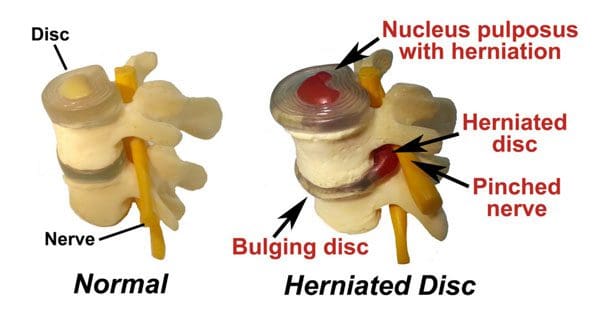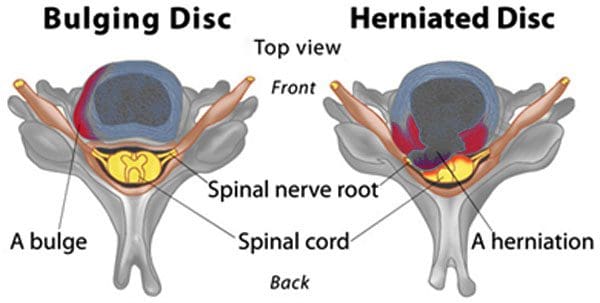Spinal Disc Herniation Chiropractic Reset

Table of Contents
Spinal Disc Herniation Differences and Similarities
Spinal disc herniation and bulging discs have similar roots that make them difficult to diagnose. Some core comparisons that can be made include:- Both include pain and tenderness
- Both are caused by cartilage movement/slippage
- They cause nerve pinching and nerve pain
- They occur more often in the neck and lower spinal regions

- Bulging discs protrude
- Herniated discs rupture
- Bulging discs are more common
- Herniated discs are less common
- Bulges are caused by constant pressure
- A herniation is caused by trauma
- Bulging discs create dull radiating pain
- Herniated discs cause sharp intense pain

Injury Effects
How the injury affects the spine and overall wellness is the objective when diagnosing. Bulging discs are often associated with chronic pain that does not go away with time and needs proper treatment. Herniated discs are considered severe because of the disc fluid spilling/leaking out affecting the surrounding nerves. Left untreated, bulging discs lead to intermittent nerve blockages/pinching and posture problems. Herniated disc left untreated leads to chronic nerve pain and permanent nerve damage, which can develop into a series of issues. This includes limited mobility and/or loss of feeling in the affected area.Early Detection
Chiropractic diagnosis for bulges and spinal disc herniation is recommended because of the specialization in spine care and focusing on all symptoms. For example, although it is not typically this simple, analysis revealing tingling in the fingers and sharp pain in the lower spine indicates herniation. Conversely, dull aches in the low back and down the legs, indicate sciatic pain that can be traced to a disc bulge. Making the correct diagnosis is crucial in developing the right treatment plan. The wrong treatment plan could result in worsening of the injury and creation of new injuries. Injury Medical Chiropractic provides optimal care along with education for patients to understand everything that is going on with their bodies.InBody Composition
Types of pain
Pain can be grouped into three categories:- Early warning pain is most recognizable with the withdrawal reflex. For example, touching a scalding hot object and quickly pulling away. A protective mechanism that helps the body avoid danger and is important for survival.
- Inflammatory pain occurs following an injury or surgery when the body is healing and in recovery. Inflammation prevents the body from moving too fast or too hard causing re-injury. This type of pain is important while healing, but is a cause for concern if it continues after the injury has healed.
- Pathological pain happens after the body has healed but the nervous system has suffered damage. This often occurs with individuals that get injured in a way that changes the way the body functions. If the nervous system does not heal properly, the body’s protective pain responses can begin to create false alarms and become chronic.
Dr. Alex Jimenez’s Blog Post Disclaimer
The scope of our information is limited to chiropractic, musculoskeletal, physical medicines, wellness, and sensitive health issues and/or functional medicine articles, topics, and discussions. We use functional health & wellness protocols to treat and support care for injuries or disorders of the musculoskeletal system. Our posts, topics, subjects, and insights cover clinical matters, issues, and topics that relate and support directly or indirectly our clinical scope of practice.* Our office has made a reasonable attempt to provide supportive citations and has identified the relevant research study or studies supporting our posts. We also make copies of supporting research studies available to the board and or the public upon request. We understand that we cover matters that require an additional explanation as to how it may assist in a particular care plan or treatment protocol; therefore, to further discuss the subject matter above, please feel free to ask Dr. Alex Jimenez or contact us at 915-850-0900. The provider(s) Licensed in Texas& New Mexico*References
Santilli, Valter et al. “Chiropractic manipulation in the treatment of acute back pain and sciatica with disc protrusion: a randomized double-blind clinical trial of active and simulated spinal manipulations.” The spine journal: official journal of the North American Spine Society vol. 6,2 (2006): 131-7. doi:10.1016/j.spinee.2005.08.001Post Disclaimer
Professional Scope of Practice *
The information herein on "Spinal Disc Herniation Chiropractic Reset" is not intended to replace a one-on-one relationship with a qualified health care professional or licensed physician and is not medical advice. We encourage you to make healthcare decisions based on your research and partnership with a qualified healthcare professional.
Blog Information & Scope Discussions
Welcome to El Paso's Wellness blog, where Dr. Alex Jimenez, DC, FNP-C, a board-certified Family Practice Nurse Practitioner (FNP-C) and Chiropractor (DC), presents insights on how our team is dedicated to holistic healing and personalized care. Our practice aligns with evidence-based treatment protocols inspired by integrative medicine principles, similar to those found on dralexjimenez.com, focusing on restoring health naturally for patients of all ages.
Our areas of chiropractic practice include Wellness & Nutrition, Chronic Pain, Personal Injury, Auto Accident Care, Work Injuries, Back Injury, Low Back Pain, Neck Pain, Migraine Headaches, Sports Injuries, Severe Sciatica, Scoliosis, Complex Herniated Discs, Fibromyalgia, Chronic Pain, Complex Injuries, Stress Management, Functional Medicine Treatments, and in-scope care protocols.
Our information scope is limited to chiropractic, musculoskeletal, physical medicine, wellness, contributing etiological viscerosomatic disturbances within clinical presentations, associated somato-visceral reflex clinical dynamics, subluxation complexes, sensitive health issues, and functional medicine articles, topics, and discussions.
We provide and present clinical collaboration with specialists from various disciplines. Each specialist is governed by their professional scope of practice and their jurisdiction of licensure. We use functional health & wellness protocols to treat and support care for the injuries or disorders of the musculoskeletal system.
Our videos, posts, topics, subjects, and insights cover clinical matters, issues, and topics that relate to and directly or indirectly support our clinical scope of practice.*
Our office has reasonably attempted to provide supportive citations and has identified the relevant research studies or studies supporting our posts. We provide copies of supporting research studies available to regulatory boards and the public upon request.
We understand that we cover matters that require an additional explanation of how they may assist in a particular care plan or treatment protocol; therefore, to discuss the subject matter above further, please feel free to ask Dr. Alex Jimenez, DC, APRN, FNP-BC, or contact us at 915-850-0900.
We are here to help you and your family.
Blessings
Dr. Alex Jimenez DC, MSACP, APRN, FNP-BC*, CCST, IFMCP, CFMP, ATN
email: coach@elpasofunctionalmedicine.com
Licensed as a Doctor of Chiropractic (DC) in Texas & New Mexico*
Texas DC License # TX5807
New Mexico DC License # NM-DC2182
Licensed as a Registered Nurse (RN*) in Texas & Multistate
Texas RN License # 1191402
ANCC FNP-BC: Board Certified Nurse Practitioner*
Compact Status: Multi-State License: Authorized to Practice in 40 States*
Graduate with Honors: ICHS: MSN-FNP (Family Nurse Practitioner Program)
Degree Granted. Master's in Family Practice MSN Diploma (Cum Laude)
Dr. Alex Jimenez, DC, APRN, FNP-BC*, CFMP, IFMCP, ATN, CCST
My Digital Business Card


